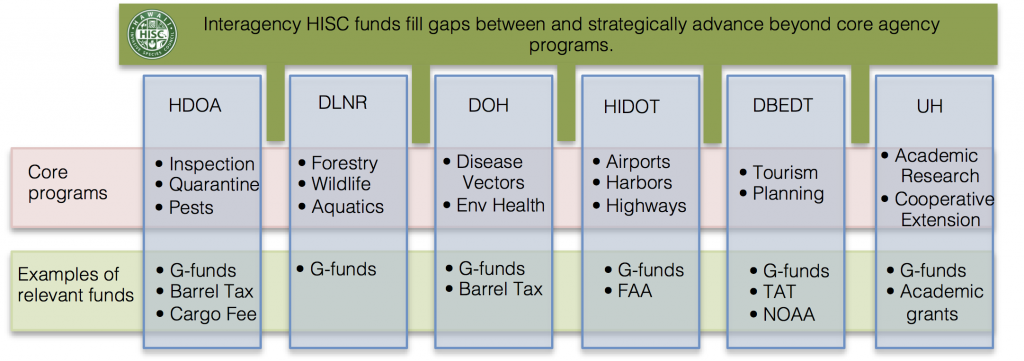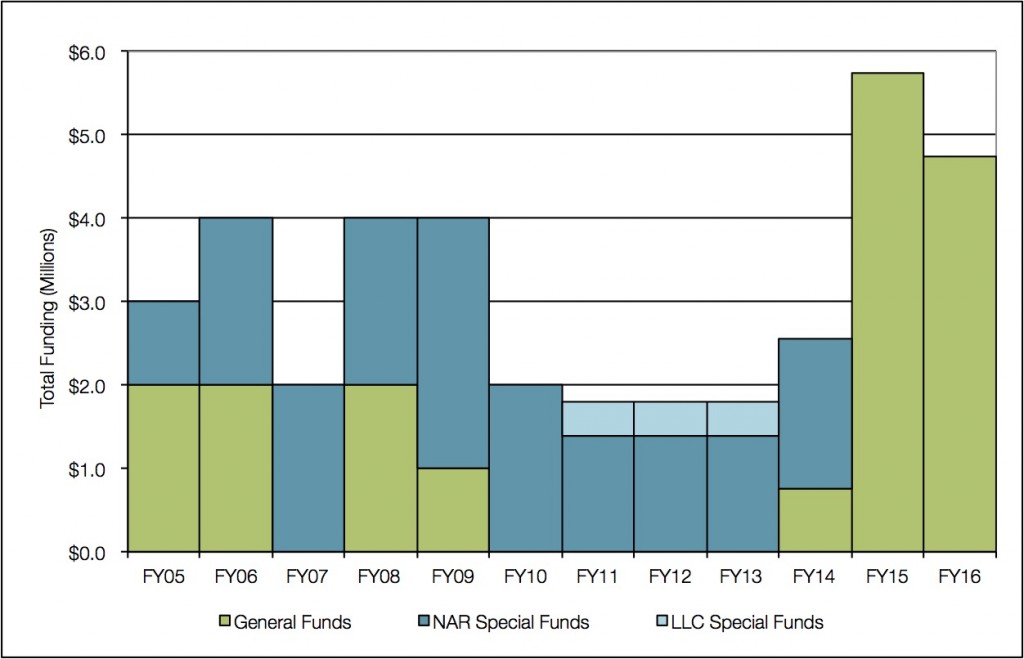HISC-Funded Projects
About HISC Funding
The Hawaii Invasive Species Council disburses funds annually for innovative projects addressing invasive species prevention, control, outreach, and research. Existing programs at state agencies address some of the core needs in this area, including inspection and quarantine at ports (HDOA), control of invasive plants and animals on state lands (DLNR), detection and control of vectors of human disease (DOH), control of invasive species along public transportation routes (DOT), planning initiatives (DBEDT), and academic expertise (UH). HISC-funded projects do not replace these core programs. Interagency HISC funds are used to complement these existing programs by:
- Filling gaps between agency mandates or existing agency programs, and/or
- Advancing our collective knowledge through research and development of new tools.
Disbursement of project funding via the HISC ensures that, at the cabinet level, multiple state agencies are identifying and prioritizing actions on annual basis that might otherwise go unfunded.

Relation of HISC funding to core agency programs. (FAA = Federal Aviation Administration; TAT = Transient Accommodations Tax; NOAA = National Oceanographic and Atmospheric Administration)
HISC Funding History
 FY05 (July 1, 2004-June 30, 2005) was the first year that funds were provided to the HISC, which is administratively housed with the DLNR Division of Forestry and Wildlife. The stated intent of the Governor at the time was a budget of $5M in general funds, to fill gaps in capacity within and between departmental projects. As the amount of available general funds available fluctuated over time, the DLNR, as administrative host to the HISC, has in the past supplemented general funds with special funds from the Natural Area Reserve Fund, which received revenues from the conveyance tax levied on the sale of property in Hawaii. Due to a lack of general funds available during the economic downturn between FY10 and FY13, the HISC temporarily received funding from the Legacy Land Conservation Program. General funds from the legislature were provided in FY14, and in FY15 the HISC was entirely supported by general funds. Though funds are administered through DLNR, all HISC funding is approved by the interagency Council.
FY05 (July 1, 2004-June 30, 2005) was the first year that funds were provided to the HISC, which is administratively housed with the DLNR Division of Forestry and Wildlife. The stated intent of the Governor at the time was a budget of $5M in general funds, to fill gaps in capacity within and between departmental projects. As the amount of available general funds available fluctuated over time, the DLNR, as administrative host to the HISC, has in the past supplemented general funds with special funds from the Natural Area Reserve Fund, which received revenues from the conveyance tax levied on the sale of property in Hawaii. Due to a lack of general funds available during the economic downturn between FY10 and FY13, the HISC temporarily received funding from the Legacy Land Conservation Program. General funds from the legislature were provided in FY14, and in FY15 the HISC was entirely supported by general funds. Though funds are administered through DLNR, all HISC funding is approved by the interagency Council.
HISC Funding Process
A call for proposals for applicants of HISC funds is released annually in late spring. HISC funds are currently available to government agencies and the UH system. For review purposes, applicants identify one of the HISC Working Groups to which their proposal should be directed based on topic (e.g., prevention, control, outreach, etc.). Proposals are then discussed at informal working group meetings. A quantitative review committee then scores the proposals and collaboratively develops a recommended budget to propose to the Council. The Council, at a public meeting, reviews the recommended budget and has the opportunity to reject, amend, or approve the budget.
Organizations interested in applying for HISC funds can contact HISC support staff for more information.
Funded Projects
The variety of projects funded in each fiscal year varies depending on available funding, current priorities, and applications received. To see projects funded by the HISC for a given fiscal year, select a fiscal year below:
FY20 (July 1, 2019 – June 30, 2020)
FY19 (July 1, 2018 – June 30, 2019)
FY18 (July 1, 2017 – June 30, 2018)
FY17 (July 1, 2016 – June 30, 2017)
FY16 (July 1, 2015 – June 30, 2016)
FY15 (July 1, 2014 – June 30, 2015)
FY14 (July 1, 2013 – June 30, 2014)
FY13 (July 1, 2012 – June 30, 2013)
FY12 (July 1, 2011 – June 30, 2012)
FY11 (July 1, 2010 – June 30, 2011)
FY10 (July 1, 2009 – June 30, 2010)
FY09 (July 1, 2008 – June 30, 2009)
FY08 (July 1, 2007 – June 30, 2008)
FY07 (July 1, 2006 – June 30, 2007)